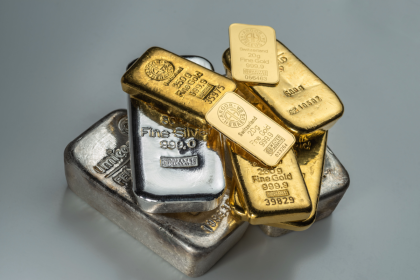Precious Metals Retreat as Dollar Strengthens and Trade Tensions Ease
Gold prices plunged in their sharpest single-day decline in more than 12 years, halting a record-setting rally that had propelled the precious metal to historic highs. Futures for gold (GC=F) fell as much as 5.5% on Tuesday, trading near $4,141 per troy ounce, while silver (SI=F) dropped over 7% — its largest one-day fall since 2021.
The steep decline followed a combination of factors: easing trade tensions between Washington and Beijing, a rebound in the U.S. dollar, and technical signals showing gold had become overbought after months of aggressive gains.
“Gold had several attempts to push above $4,400, starting last Thursday. But on each occasion, it ran into resistance,” said David Morrison, senior market analyst at Trade Nation. “The key question now is whether this slide marks the start of a needed correction or just a temporary dip.”
Correction or Buying Opportunity?
According to Morrison, the first key support level lies near $4,000 per ounce. “It’s quite possible that this is all we get from the dip and that buyers return around $4,200,” he added.
The sudden pullback came just days after investors had “bought the dip” when gold briefly dropped 1.5% last Friday. The latest sell-off follows months of remarkable gains, as gold and equity markets both reached all-time highs in October.
“This is just a bump in the road,” said Tom Essaye, founder of Sevens Report Research. “You still have elevated inflation, low real interest rates, geopolitical concerns, and U.S. government dysfunction. That’s all a bullish cocktail for gold.”
Rally Fueled by Central Banks and ETF Inflows
Despite Tuesday’s rout, gold has surged 28% since mid-August, driven by robust central bank purchases and strong inflows into gold-backed ETFs. Investors have sought the metal as a hedge against persistent inflation, fiscal instability, and weakening confidence in fiat currencies.
“What would break the back of gold would be if we greatly reduced our debt — which isn’t happening — and if peace broke out globally,” said Michele Schneider, chief strategist at MarketGauge.com. “Until then, gold remains a core hedge.”
While short-term volatility is rattling some traders, most analysts see the pullback as part of a broader upward trajectory. Morrison and Essaye both noted that as long as inflation stays elevated and real rates remain low, gold’s long-term fundamentals remain intact.
Wall Street Still Sees Gold Going Higher
Major financial institutions continue to forecast higher prices for the yellow metal. Bank of America reiterated its “long gold” recommendation, predicting a $6,000 per ounce peak by mid-2026.
Goldman Sachs recently raised its year-end 2026 forecast to $4,900 per troy ounce, up from $4,300, while JPMorgan expects gold could reach $6,000 by 2029 as long-term inflation and currency pressures persist.
For now, traders are watching the $4,000–$4,200 range closely to see if buyers return to support the market. Whether this marks the start of a broader correction or a pause in an ongoing bull run, one thing is clear: gold’s volatility is back.






